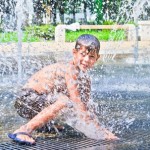Benefits of Yoga for Kids of All Ages
 Recently, I sat down with Pam Chmiel, yoga instructor extraordinaire and mom of three, to talk about yoga for kids of all ages and stages. Practicing for more than 30 years, Pam became certified as a yoga instructor 11 years ago. During our conversation, Pam detailed the wide-ranging and unique benefits of yoga, far beyond flexibility and strength-building, for every stage. Here’s what she had to say.
Recently, I sat down with Pam Chmiel, yoga instructor extraordinaire and mom of three, to talk about yoga for kids of all ages and stages. Practicing for more than 30 years, Pam became certified as a yoga instructor 11 years ago. During our conversation, Pam detailed the wide-ranging and unique benefits of yoga, far beyond flexibility and strength-building, for every stage. Here’s what she had to say.
Babies
Yoga can be a great help in easing colic in babies with simple postures such as knees to chest. It also supports the development of gross motor skills with movements like rotating the hips and of fine motor skills with movements like rotating the hands and toes. What’s more, yoga works to foster the child-parent bond through the power of touch.
Toddlers
At this age, building self-confidence is a key part of yoga. I often have my students repeat positive affirmations such as “I am strong,” “I am brave” and “I am kind” while doing a sequence like a sun salutation. The kids love it! For them, it’s a fun, non-competitive activity. The toddlers are getting tons of benefits without even knowing it.
School Age
Breathe comes into play at this stage and does wonders to de-stress kids. The children quickly realize that by taking a few deep, mindful breaths, their moods vastly improve, decreasing their stress levels. It’s an essential life skill that’s great to learn so early on. Yoga also helps to ease shoulder and back strain often due to today’s loaded-down backpacks.
Teens
For teens, the philosophy of yoga moves into the picture, bringing a heightened awareness of the mind-body connection. Teens are learning about how to take care of their bodies, not only through yoga but also in terms of the foods they are eating. Yoga becomes a powerful tool in improving self- control and increasing their sense of right and wrong.
Special Needs
For a child with special needs, the first step is talking with his or her health care providers and/or physical therapists to decide if yoga is right for him or her. After that, you can try out group settings or private instruction, in which an instructor can be more hands-on until he or she learns the poses, depending on the child’s comfort level.
– Attention Disorders
If a child has an attention disorder, one of the main goals is to help quiet the mind and tap into the mind-body connection. Yoga can bring increased focus and concentration through specific poses like downward-facing dog and balance poses as well as breathing and meditation. The repetition of poses is an essential component as well.
– Special Physical Challenges
Children with hyper-mobility benefit from yoga as it helps to strengthen muscles, giving them more physical control over their bodies. For children with constricted mobility, yoga aids in stretching and loosening the joints and muscles to keep their bodies mobile.
– Autism
The routine and repetition of yoga can be a powerful tool for children with autism and can work to build self-esteem. First and foremost though, the children have to feel comfortable, and have a sense of trust with, their yoga teacher. If the child is comfortable with touch, partner yoga can help in fostering that bond.
The bottom line? Yoga is fun for all ages and works great as a family activity too!



















